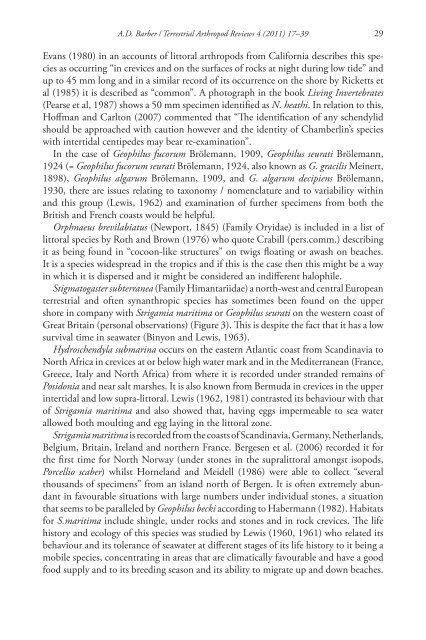Geophilomorph centipedes and the littoral habitat - Books and ...
Geophilomorph centipedes and the littoral habitat - Books and ...
Geophilomorph centipedes and the littoral habitat - Books and ...
Create successful ePaper yourself
Turn your PDF publications into a flip-book with our unique Google optimized e-Paper software.
A.D. Barber / Terrestrial Arthropod Reviews 4 (2011) 17–39 29<br />
Evans ( 1980 ) in an accounts of <strong>littoral</strong> arthropods from California describes this species<br />
as occurring “in crevices <strong>and</strong> on <strong>the</strong> surfaces of rocks at night during low tide” <strong>and</strong><br />
up to 45 mm long <strong>and</strong> in a similar record of its occurrence on <strong>the</strong> shore by Ricketts et<br />
al ( 1985 ) it is described as “common”. A photograph in <strong>the</strong> book Living Invertebrates<br />
(Pearse et al, 1987 ) shows a 50 mm specimen identifi ed as N. heathi . In relation to this,<br />
Hoff man <strong>and</strong> Carlton ( 2007 ) commented that “Th e identifi cation of any schendylid<br />
should be approached with caution however <strong>and</strong> <strong>the</strong> identity of Chamberlin’s species<br />
with intertidal <strong>centipedes</strong> may bear re-examination”.<br />
In <strong>the</strong> case of Geophilus fucorum Brölemann, 1909, Geophilus seurati Brölemann,<br />
1924 (= Geophilus fucorum seurati Brölemann, 1924, also known as G. gracilis Meinert,<br />
1898), Geophilus algarum Brölemann, 1909, <strong>and</strong> G. algarum decipiens Brölemann,<br />
1930 , <strong>the</strong>re are issues relating to taxonomy / nomenclature <strong>and</strong> to variability within<br />
<strong>and</strong> this group (Lewis, 1962 ) <strong>and</strong> examination of fur<strong>the</strong>r specimens from both <strong>the</strong><br />
British <strong>and</strong> French coasts would be helpful.<br />
Orphnaeus brevilabiatus (Newport, 1845) (Family Oryidae) is included in a list of<br />
<strong>littoral</strong> species by Roth <strong>and</strong> Brown ( 1976 ) who quote Crabill (pers.comm.) describing<br />
it as being found in “cocoon-like structures” on twigs fl oating or awash on beaches.<br />
It is a species widespread in <strong>the</strong> tropics <strong>and</strong> if this is <strong>the</strong> case <strong>the</strong>n this might be a way<br />
in which it is dispersed <strong>and</strong> it might be considered an indiff erent halophile.<br />
Stigmatogaster subterranea (Family Himantariidae) a north-west <strong>and</strong> central European<br />
terrestrial <strong>and</strong> often synanthropic species has sometimes been found on <strong>the</strong> upper<br />
shore in company with Strigamia maritima or Geophilus seurati on <strong>the</strong> western coast of<br />
Great Britain (personal observations) ( Figure 3 ). Th is is despite <strong>the</strong> fact that it has a low<br />
survival time in seawater (Binyon <strong>and</strong> Lewis, 1963 ).<br />
Hydroschendyla submarina occurs on <strong>the</strong> eastern Atlantic coast from Sc<strong>and</strong>inavia to<br />
North Africa in crevices at or below high water mark <strong>and</strong> in <strong>the</strong> Mediterranean (France,<br />
Greece, Italy <strong>and</strong> North Africa) from where it is recorded under str<strong>and</strong>ed remains of<br />
Posidonia <strong>and</strong> near salt marshes. It is also known from Bermuda in crevices in <strong>the</strong> upper<br />
intertidal <strong>and</strong> low supra-<strong>littoral</strong>. Lewis ( 1962 , 1981 ) contrasted its behaviour with that<br />
of Strigamia maritima <strong>and</strong> also showed that, having eggs impermeable to sea water<br />
allowed both moulting <strong>and</strong> egg laying in <strong>the</strong> <strong>littoral</strong> zone.<br />
Strigamia maritima is recorded from <strong>the</strong> coasts of Sc<strong>and</strong>inavia, Germany, Ne<strong>the</strong>rl<strong>and</strong>s,<br />
Belgium, Britain, Irel<strong>and</strong> <strong>and</strong> nor<strong>the</strong>rn France. Bergesen et al. (2006) recorded it for<br />
<strong>the</strong> fi rst time for North Norway (under stones in <strong>the</strong> supra<strong>littoral</strong> amongst isopods,<br />
Porcellio scaber ) whilst Hornel<strong>and</strong> <strong>and</strong> Meidell ( 1986 ) were able to collect “several<br />
thous<strong>and</strong>s of specimens” from an isl<strong>and</strong> north of Bergen. It is often extremely abundant<br />
in favourable situations with large numbers under individual stones, a situation<br />
that seems to be paralleled by Geophilus becki according to Habermann (1982). Habitats<br />
for S.maritima include shingle, under rocks <strong>and</strong> stones <strong>and</strong> in rock crevices. Th e life<br />
history <strong>and</strong> ecology of this species was studied by Lewis (1960, 1961 ) who related its<br />
behaviour <strong>and</strong> its tolerance of seawater at diff erent stages of its life history to it being a<br />
mobile species, concentrating in areas that are climatically favourable <strong>and</strong> have a good<br />
food supply <strong>and</strong> to its breeding season <strong>and</strong> its ability to migrate up <strong>and</strong> down beaches.









![Am HaSefer [Volk des Buches] - Books and Journals](https://img.yumpu.com/20648352/1/174x260/am-hasefer-volk-des-buches-books-and-journals.jpg?quality=85)







